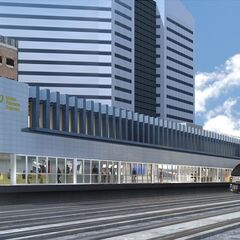I completely support this movement and its goals. Electrification of these lines is long overdue, both for environmental and operational reasons. GO is also much more likely to offer a real regional rail service if it has the electrical infrastructure and EMUs rather than the standard Gary McNeil 10-car diesel bilevel trains every hour.
I agree electrification offers environmental and operational benefits. However, electrification does not offer the highest environmental or operational benefits for their cost. We operate in a limited funding environment. It is prudent to ensure investments are the most effective solution for the supposed problem. The key there is different people suppose different problems.
I just don't understand the phenomeon of transit advocates who constantly try to advocate cheaping out on transit projects...
It's called compromise. I want the highest level of service. I need a minimum level of service. Reality falls somewhere in between.[/QUOTE]
That's a completely false choice. Has anybody presented those as the two options? If we have to cut other transit projects to pay for it (which, again, is far from certain), I can think of a fair number that could stand a trim.
It is, as Metrolinx won't build subways, so I'll pick one of the 15 Big Move projects that the Lakeshore Express Rail competes directly against: 403 Transitway from Mississauga City Centre to the Renforth Gateway.
The Georgetown expansion is already causing GO to cancel/delay several minor projects due to budget constraints. Expect this to become much more obvious in 2014/2015.
Regardless of how Metrolinx spend's their funding, ultimately the cost for ANY transit develop comes from taxpayers and user-fees, and we should apply pressure to all levels of government and government agencies to fund the projects we feel are 'most worthy'.
I'm not so sure I follow you here. Are you aware that there is a total re-tracking currently happening along the Georgetown rail corridor? Are you saying that the new tracks are not being built in a fashion that allows such maintenance to occur in an electrified future? If you are right about that, then it's a major show of incompetence. I certainly hope you are wrong.
I am saying the Georgetown expansion allows for electrification height requires on structures, but horizontal track spacing has not been agreed with CP/CN. Why is it incompetence to not know what outside parties will demand?
Did you forget to read the part where electrification pays for itself in 10 years of operational savings? That means 11 years after electrification, we're getting a SURPLUS in transit budget compared to a no-electrification scenario. That is why this is a fallacy to call it not-cost-effective, too expensive, etc.
I did forget to read that part, as I like to draw my own conclusions based on the information within reports. Specifically to 2031 total operating cost savings are $648m (1888m - 1.24b) between diesal expansion and electric where as costs are $5,115m more. This leaves a price tag of $4,467m for 18,480 additional seats ($241,720 per seat or $66.15 per seat-day for 10 years) compared to diesal of $858m for 7,700 ($111,428 per seat).
Diesal option has a net present value of $120m in incremental fare revenue. Electrfication has a net value of $420m ($190m + $230m). This means there return periods are: Diesal - 858m/120m = 7.15 years and Electric - 5973m/420m = 14.22 years. However, the diesal return is from 2015 and 'paid off' in 2022, while the electric return is from 2031 and 'paid off' in 2045.







